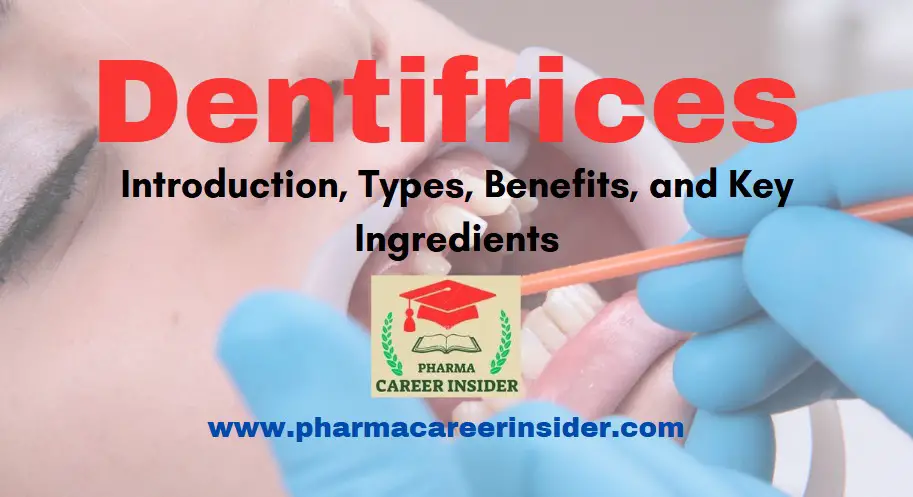Meta Description:
Discover everything about dentifrices, including types, benefits, key ingredients, and how to choose the best toothpaste for oral health. Learn about fluoride, whitening, herbal, and anti-sensitivity toothpaste to maintain a healthy smile!
Introduction
Dentifrices are substances used alongside toothbrushes to clean teeth, remove plaque, and freshen breath. They play a crucial role in oral hygiene by preventing cavities, reducing gum diseases, and maintaining overall dental health. Available in various forms such as toothpaste, powders, and gels, dentifrices contain active ingredients that help in tooth remineralization, whitening, and bacterial control.
This detailed post explores the types, benefits, ingredients, and considerations when choosing a dentifrice for optimal oral health.
Types of Dentifrices
There are several types of dentifrices available, each catering to different oral health needs:
1. Fluoride Toothpaste: The most commonly used dentifrice.Contains fluoride compounds like sodium fluoride (NaF) or stannous fluoride (SnF₂).Thishelps strengthen enamel and prevent tooth decay.
2. Whitening Toothpaste: This contains mild abrasives and chemical agents like hydrogen peroxide or carbamide peroxide.Helps remove surface stains and brighten teeth.Safe for daily use but may cause sensitivity in some individuals.
3. Herbal or Natural Dentifrices: It’smade from plant-based ingredients like neem, clove, and miswak.They free from artificial Flavors, colors, and fluoride.Preferred by individuals looking for chemical-free oral care.
4. Anti-Sensitivity Toothpaste: This Contains potassium nitrate or strontium chloride to reduce tooth sensitivity.They alsohelp desensitize nerve endings and block pain signals.Recommended for individuals with sensitive teeth.
5. Tartar Control Dentifrices: Tartar control dentifrices contain pyrophosphates or zinc citrate to prevent tartar buildup.They help in reducing plaque formation and maintaining gum health.
6. Charcoal-Based Toothpaste: Charcoal-based dentifrices contain activated charcoal, which is primarily used for stain removal and detoxification. These products claim to absorb toxins, bacteria, and impurities from the mouth, promoting better oral health. However, scientific evidence supporting these claims is limited, and excessive use of charcoal toothpaste may lead to enamel erosion due to its abrasive nature.
7. Medicated Dentifrices: Medicated dentifrices are specially formulated and prescribed for individuals with specific oral health conditions such as gingivitis, periodontitis, or oral ulcers. These dentifrices contain antimicrobial agents like triclosan or chlorhexidine, which help reduce bacterial growth, control plaque buildup, and prevent gum infections. They are typically recommended by dental professionals for short-term use, as prolonged usage may lead to potential side effects such as altered taste perception or staining of teeth.
Key Ingredients in Dentifrices
Dentifrices contain a variety of active and inactive ingredients that contribute to their effectiveness:
1. Active Ingredients
- Fluoride: Strengthens enamel and prevents cavities.
- Potassium Nitrate: Reduces tooth sensitivity.
- Hydrogen Peroxide: Helps in teeth whitening.
- Triclosan: Antibacterial agent for plaque control (less commonly used now).
- Zinc Citrate: Prevents tartar buildup.
2. Abrasives
- Help remove plaque and stains without damaging enamel.
- Common abrasives: Calcium carbonate, silica, alumina.
3. Humectants
- Retain moisture to prevent the toothpaste from drying out.
- Examples: Glycerin, sorbitol, propylene glycol.
4. Detergents (Foaming Agents)
- Create foam to distribute the toothpaste evenly.
- Commonly used: Sodium lauryl sulfate (SLS).
5. Flavoring Agents
- Provide a pleasant taste and fresh breath.
- Includes mint, cinnamon, or fruit flavors.
6. Binders and Thickeners
- Maintain consistency and texture.
- Commonly used: Xanthan gum, cellulose gum.
7. Preservatives
- Prevent bacterial growth in toothpaste tubes.
- Includes parabens and benzoates.
Benefits of Using Dentifrices
- 1. Prevention of Tooth Decay: Fluoride in dentifrices helps strengthen enamel and prevent cavities.
- 2. Plaque and Tartar Control: Active ingredients work to reduce plaque accumulation and tartar formation.
- 3. Freshens Breath: Mint and antibacterial agents combat bad breath.
- 4. Whitening Effects: Abrasives and peroxide compounds help in stain removal and teeth brightening.
- 5. Gum Disease Prevention: Medicated dentifrices help control gingivitis and periodontitis.
- 6. Reduces Tooth Sensitivity: Potassium nitrate helps in reducing pain caused by temperature changes.
How to Choose the Right Dentifrice?
Selecting the best dentifrice depends on individual oral health needs:
- For cavity prevention → Choose fluoride toothpaste.
- For sensitive teeth → Opt for anti-sensitivity toothpaste.
- For gum disease → Use a medicated dentifrice recommended by a dentist.
- For teeth whitening → Select a whitening toothpaste with mild abrasives.
- For a natural alternative → Herbal toothpaste is a good option.
Potential Risks and Precautions
While dentifrices are generally safe, some precautions should be taken:
- Excessive fluoride use can cause fluorosis, leading to white spots on teeth.
- Sodium lauryl sulfate (SLS) may cause mouth ulcers in sensitive individuals.
- Charcoal toothpaste can be overly abrasive and wear down enamel over time.
- Children under six should use a pea-sized amount of fluoride toothpaste under supervision to avoid swallowing.
Conclusion
Dentifrices are an essential part of daily oral hygiene, helping to prevent cavities, maintain gum health, and improve overall dental care. With various formulations available, choosing the right type depends on individual needs. Whether opting for a fluoride toothpaste, herbal alternative, or whitening formula, using a dentifrice regularly ensures a healthy and confident smile.
For best results, always use a dentist-recommended dentifrice and follow a consistent oral hygiene routine, including brushing twice daily and flossing.




Well explanation.
Keep it up.
Pharma team
Thank you for giving valuable contact
Undeniably believe that which you said. Your favorite justification appeared to be on the web the simplest thing to be aware of. I say to you, I certainly get annoyed while people consider worries that they just don’t know about. You managed to hit the nail upon the top and also defined out the whole thing without having side-effects , people can take a signal. Will likely be back to get more. Thanks
Hi my friend! I want to say that this article is amazing, nice written and include almost all vital infos. I抎 like to see more posts like this.